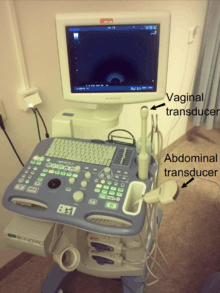Prenatal heartbeat

Prenatal heartbeat (usually called embryonic heartbeat before approximately 10 weeks of gestational age and then fetal heartbeat until birth) is the contractions during the cardiac cycles of an embryo or fetus.
In cases of early pregnancy bleeding, the detection of prenatal heartbeat is the main finding that distinguishes a viable pregnancy from a silent miscarriage.
Acquisition

In the first trimester, heartbeat can be visualized and the heart rate quantified by obstetric ultrasonography. A study of 32 normal pregnancies came to the result a fetal heartbeat was visible at a mean human chorionic gonadotropin (hCG) level of 10,000 UI/l (range 8650-12,200).[1] Obstetric ultrasonography can also use doppler technique on key vessels such as the umbilical artery can detect abnormal flow.

In later stages of pregnancy, a simple Doppler fetal monitor can quantify the fetal heart rate.
During childbirth, the parameter is part of cardiotocography, which is where the fetal heartbeat and uterine contractions are continuously recorded.
Fetal heart rates
Starting at week 5 the fetal heart rate accelerates by 3.3 bpm per day for the next month.
The fetal heart begins to beat at approximately the same rate as the mother's, which is typically 80 to 85 bpm. The approximate fetal heart rate for weeks 5 to 9 (assuming a starting rate of 80):
- Week 5 starts at 80 and ends at 103 bpm
- Week 6 starts at 103 and ends at 126 bpm
- Week 7 starts at 126 and ends at 149 bpm
- Week 8 starts at 149 and ends at 172 bpm
- At week 9 the fetal heartbeat tends to beat within a range of 155 to 195 bpm.
At this point, the fetal heart rate begins to decrease, and generally falls within the range of 120 to 160 bpm by week 12.[2]

See also
References
- ↑ Giacomello F, Magliocchetti P, Loyola G, Giovarruscio M (1993). "[Serum beta hCG levels and transvaginal echography in the early phases of pregnancy]". Minerva Ginecol (in Italian) 45 (7-8): 333–7. PMID 8414139.
- ↑ FetalSure. Fetal Heart and Heartbeat Facts. Available at http://www.fetalsure.com/fetal-heart.html. Retrieved 9 August 2010.